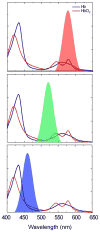Enhanced surgical imaging: laparoscopic vessel identification and assessment of tissue oxygenation
- PMID: 18501814
- PMCID: PMC2749562
- DOI: 10.1016/j.jamcollsurg.2008.01.013
Enhanced surgical imaging: laparoscopic vessel identification and assessment of tissue oxygenation
Abstract
Background: Inherent to minimally invasive procedures are loss of tactile feedback and loss of three-dimensional assessment. Tasks such as vessel identification and dissection are not trivial for the inexperienced laparoscopic surgeon. Advanced surgical imaging, such as 3-charge-coupled device (3-CCD) image enhancement, can be used to assist with these more challenging tasks and, in addition, offers a method to noninvasively monitor tissue oxygenation during operations.
Study design: In this study, 3-CCD image enhancement is used for identification of vessels in 25 laparoscopic donor and partial nephrectomy patients. The algorithm is then applied to two laparoscopic nephrectomy patients involving multiple renal arteries. We also use the 3-CCD camera to qualitatively monitor renal parenchymal oxygenation during 10 laparoscopic donor nephrectomies (LDNs).
Results: The mean region of interest (ROI) intensity values obtained for the renal artery and vein (68.40 +/- 8.44 and 45.96 +/- 8.65, respectively) are used to calculate a threshold intensity value (59.00) that allows for objective vessel differentiation. In addition, we examined the renal parenchyma during LDNs. Mean ROI intensity values were calculated for the renal parenchyma at two distinct time points: before vessel stapling (nonischemic) and just before extraction from the abdomen (ischemic). The nonischemic mean ROI intensity values are statistically different from the ischemic mean ROI intensity values (p < 0.05), even with short ischemia times.
Conclusions: We have developed a technique, 3-CCD image enhancement, for identification of vasculature and monitoring of parenchymal oxygenation. This technique requires no additional laparoscopic operating room equipment and has real-time video capability.
Figures





Similar articles
-
Visual enhancement of laparoscopic partial nephrectomy with 3-charge coupled device camera: assessing intraoperative tissue perfusion and vascular anatomy by visible hemoglobin spectral response.J Urol. 2010 Oct;184(4):1279-85. doi: 10.1016/j.juro.2010.06.010. Epub 2010 Aug 17. J Urol. 2010. PMID: 20723937 Free PMC article.
-
Non-invasive monitoring of tissue oxygenation during laparoscopic donor nephrectomy.BMC Surg. 2008 Apr 17;8:8. doi: 10.1186/1471-2482-8-8. BMC Surg. 2008. PMID: 18419819 Free PMC article.
-
Comparison of renal ischemic damage during laparoscopic partial nephrectomy with artery-vein and artery-only clamping.J Endourol. 2014 Mar;28(3):306-11. doi: 10.1089/end.2013.0446. Epub 2013 Nov 19. J Endourol. 2014. PMID: 24099438
-
Hem-o-lok clips to control both the artery and the vein during laparoscopic nephrectomy: personal experience and review of the literature.J Endourol. 2007 Aug;21(8):915-8. doi: 10.1089/end.2006.0101. J Endourol. 2007. PMID: 17867953 Review.
-
Eliminating global renal ischemia during partial nephrectomy: an anatomical approach.Curr Opin Urol. 2012 Mar;22(2):83-7. doi: 10.1097/MOU.0b013e32834ef70c. Curr Opin Urol. 2012. PMID: 22223066 Review.
Cited by
-
Preclosure spectroscopic differences between healed and dehisced traumatic wounds.PLoS One. 2018 Sep 27;13(9):e0204453. doi: 10.1371/journal.pone.0204453. eCollection 2018. PLoS One. 2018. PMID: 30261011 Free PMC article.
-
Live augmented reality: a new visualization method for laparoscopic surgery using continuous volumetric computed tomography.Surg Endosc. 2010 Aug;24(8):1976-85. doi: 10.1007/s00464-010-0890-8. Epub 2010 Feb 21. Surg Endosc. 2010. PMID: 20174949
-
Noninvasive Multimodal Imaging to Predict Recovery of Locomotion after Extended Limb Ischemia.PLoS One. 2015 Sep 14;10(9):e0137430. doi: 10.1371/journal.pone.0137430. eCollection 2015. PLoS One. 2015. PMID: 26368024 Free PMC article.
-
Blood vessel detection, localization and estimation using a smart laparoscopic grasper: a Monte Carlo study.Biomed Opt Express. 2018 Apr 3;9(5):2027-2040. doi: 10.1364/BOE.9.002027. eCollection 2018 May 1. Biomed Opt Express. 2018. PMID: 29760967 Free PMC article.
-
Visual enhancement of laparoscopic partial nephrectomy with 3-charge coupled device camera: assessing intraoperative tissue perfusion and vascular anatomy by visible hemoglobin spectral response.J Urol. 2010 Oct;184(4):1279-85. doi: 10.1016/j.juro.2010.06.010. Epub 2010 Aug 17. J Urol. 2010. PMID: 20723937 Free PMC article.
References
-
- Khauli RB, El-Hout Y, Hussein M, et al. A controlled sequential evaluation of laparoscopic donor nephrectomy versus open donor nephrectomy: an update. Transplant Proc. 2005;37:633–634. - PubMed
-
- Lind MY, Ijzermans JNM, Bonjer HJ. Open vs laparoscopic donor nephrectomy in renal transplantation. Br J Urol Int. 2002;89:162–168. - PubMed
-
- Bykowski J, Kollias N, LaMuraglia GM. Evaluation of peripheral arterial occlusive disease and postsurgical viability using reflectance spectroscopy of skin. Microvasc Res. 2004;67:152–158. - PubMed
-
- Knoefel WT, Kollias N, Rattner DW, Nishioka NS, Warshaw AL. Reflectance soectroscopy of pancreatic microcirculation. J Appl Physiol. 1996;80:116–123. - PubMed
-
- Kostenich G, Kimel S, Peled S, Orenstein A. Monitoring PDT-induced damage using spectrally resolved reflectance imaging of tissue oxygenation. Cancer Letters. 2005;219:169–175. - PubMed
Publication types
MeSH terms
Substances
Grants and funding
LinkOut - more resources
Full Text Sources

